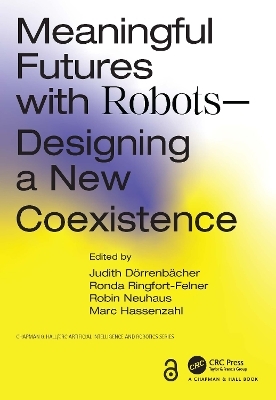
Meaningful Futures with Robots
Chapman & Hall/CRC (Verlag)
978-1-032-24648-2 (ISBN)
Meaningful Futures with Robots: Designing a New Coexistence provides insight into the opportunities and risks that arise from living with robots in the future, anchored in current research projects on everyday robotics. As well as generating ideas for robot developers and designers, it also critically discusses existing theories and methods for social robotics from different perspectives - ethical, design, artistical and technological – and presents new approaches to meaningful human-robot interaction design.
Key Features:
Provides insights into current research on robots from different disciplinary angles with a particular focus on a value-driven design.
Includes contributions from designers, psychologists, engineers, philosophers, artists, and legal scholars, among others.
Licence line: Chapters 1, 3, 12, and 15 of this book are available for free in PDF format as Open Access from the individual product page at www.crcpress.com. They have been made available under a Creative Commons Attribution-Non Commercial-No Derivatives 4.0 license.
Dr. Judith Dörrenbächer is a design researcher at the chair for “Ubiquitous Design / Experience and Interaction” at the University of Siegen. Educated in design, her current focus is on performative methods in design, on theories about animism transferred to HCI and design (techno-animism) and on interaction and design strategies of social robots. Ronda Ringfort-Felner is a research assistant at the chair for “Ubiquitous Design / Experience and Interaction” at the University of Siegen. With a background in design and HCI, her research focuses on design fiction, the design and exploration of future intelligent autonomous systems such as social robots, and the exploration of the related societal and social implications. Robin Neuhaus is a research assistant at the chair for “Ubiquitous Design / Experience and Interaction“ at the University of Siegen. With a background in industrial design and HCI, his current research focuses on the design of experiences and interactions with robots, voice assistants and other non-human actors. Dr. Marc Hassenzahl is Professor for "Ubiquitous Design / Experience and Interaction" at the University of Siegen. He combines his training in psychology with a love for interaction design. With his group of designers and psychologists, he explores the theory and practice of designing pleasurable, meaningful and transforming interactive technologies.
1. Towards Designing Meaningful Relationships with Robots
2. Concept and Content of the Book
Part 1 Designing a New Species Interaction Design and Product Design of Robots
3. How to Design Robots with Superpowers
Robin Neuhaus, Ronda Ringfort Felner, Judith Dörrenbächer, Marc Hassenzahl
4. Social Robots Should Mediate, not Replace, Social Interactions
Timo Kaerlein
5. Neither Human Nor Computer —A Symbiotic Human-Robot Collaboration in Autism Therapy
Ronda Ringfort-Felner, Judith Dörrenbächer
6. Counting Characters and Spaces—On Robot Disabilities, Robot Care, and Technological Dependencies
Lenneke Kuijer
7. Designing Robots with Personality
Lara Christoforakos, Sarah Diefenbach, Daniel Ullrich
8. Designing Robots as Social Counterparts— A Discussion about a Technology Claiming its Own Needs
Lara Christoforakos, Tobias Störzinger
9. Falling in Love With a Machine— What Happens if the Only Affection a Person Gets is From Machines?
Felix Carros (F.C.), Anne Wierling (A.W.), Adrian Preussner (A.P.)
10. I am Listening to You!—How to Make Different Robotic Species Speak the Same Language
Judith Dörrenbächer, Anne Wierling
11. How to Really Get in Touch with Robots—Haptic Interaction Technologies for VR and Teleoperation
Bernhard Weber, Thomas Hulin, Lisa Schiffer
Part 2 Designing Future Enviroments—Social Innovation Initiated by Robots
12. Design Fiction—The Future of Robots Needs Imagination
Ronda Ringfort-Felner, Robin Neuhaus, Judith Dörrenbächer, Marc Hassenzahl
13. Cramer’s Funeral Service for Androids
Uwe Post
14. Googly Eyes
Marc Hassenzahl
15 Empathizing with Robots—Animistic and Performative Methods to Anticipate a Robot’s Impact
Judith Dörrenbächer, Marc Hassenzahl
16. From the Lab to a Real-World Supermarket— About Anticipating the Chances and Challenges of a Shopping
Robot Robin Neuhaus, Judith Dörrenbächer
17. Dominant, Persuasive or Polite?— About Human Curiosity, Provocative Users and Solving Conflicts between Humans and Robots
Judith Dörrenbächer
18. Seven Observations, or Why Domestic Robots are Struggling to Enter the Habitats of Everyday Life
James Auger
19. Is this a Patient or a Wall?— Adapting Robots from an Industrial Context to a Rehabilitation Clinic
Jochen Feitsch, Bernhard Weber
20. Robotics x Book Studies Imagining a Robotic Archive of Embodied Knowledge
Corinna Norrick-Rühl
21. "That’s the Future, I’m Telling You.”
Antje Herden
22. Graphic Recording Cool Johanna Benz
Part 3 Designing together with People— Civic Participation and Ethical Implications Concerning Robots
23. Citizen Participation in Social Robotics Research
Felix Carros, Johanna Langendorf, Dave Randall, Rainer Wieching, Volker Wulf
24. Learning from Each Other— How Roboticists Learn from Users and how Users Teach their Robots
Felix Carros, Adrian Preussner
25. My Friend Simsala, the Robot
Edi Haug, Laura M. Schwengber
26. Move Away from the Stereotypical User in the Picture-perfect Scenario—A Plea for Early and Broad User Integration
Stephanie Häusler Weiss, Kilian Röhm, Tobias Störzinger
27. Is it Good?— A Philosophical Approach Towards Ethics Centered- Design (ECD)
Catrin Misselhorn, Manuel Scheidegger, Tobias Störzinger
28. Are Robots Good at Everything? A Robot in an Elementary School
Elke Buttgereit
29. The Medium has a Message Educational Robots in a Didactic Triangle
Scarlet Schaffrath
30. The Friendly Siblings of Workhorses and Killer Robots—About Becoming Alive Through the Nonliving, and Feeling Blessed by a Religious Machine
Ilona Nord
| Erscheinungsdatum | 08.11.2022 |
|---|---|
| Reihe/Serie | Chapman & Hall/CRC Artificial Intelligence and Robotics Series |
| Zusatzinfo | 104 Halftones, color; 104 Illustrations, color |
| Sprache | englisch |
| Maße | 178 x 254 mm |
| Gewicht | 800 g |
| Themenwelt | Informatik ► Theorie / Studium ► Künstliche Intelligenz / Robotik |
| ISBN-10 | 1-032-24648-0 / 1032246480 |
| ISBN-13 | 978-1-032-24648-2 / 9781032246482 |
| Zustand | Neuware |
| Informationen gemäß Produktsicherheitsverordnung (GPSR) | |
| Haben Sie eine Frage zum Produkt? |
aus dem Bereich


